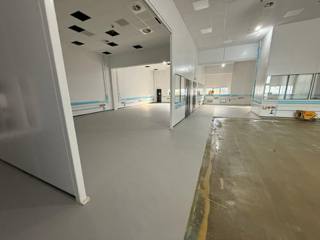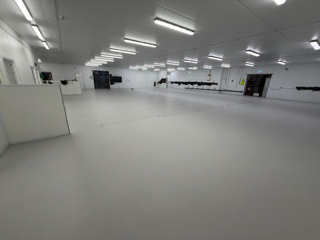
The UK’s leading resin flooring specialist
What Are Anti-Static Floors and How Do They Work?
In industrial and commercial environments where static electricity poses a serious risk, whether to sensitive electronic equipment or flammable materials, anti-static floors play a vital role in workplace health and safety. From cleanrooms to pharmaceutical laboratories or chemical processing plants, static control is essential to prevent costly damage and avoid safety hazards.
Electrostatic discharge (ESD) can damage expensive equipment, impact production and products, and compromise people’s safety in volatile environments. Anti-static flooring is designed to minimise the build-up and discharge of static electricity, offering controlled dissipation to protect your operations.
Electrostatic Discharge (ESD) Explained
Electrostatic discharge (ESD), sometimes known as electrostatic dissipation, is the sudden release of static electricity built up on a surface. It’s typically caused by friction between materials, such as personnel walking across floors, machinery operation, or material handling processes. The charge accumulates until it reaches a sufficient voltage to discharge.
You might be familiar with the “shock” sensation of a slight static discharge, which is generally harmless. In commercial and industrial settings, though, ESD can damage sensitive electronic components worth thousands of pounds, corrupt important data, or ignite flammable substances. Larger discharges can disrupt manufacturing processes and cleanroom operations, or even trigger an explosion. That’s why ESD flooring is a critical safety and operational imperative for any facility handling sensitive electronics, chemicals, or flammable materials.
What are anti-static floors?
Uncontrolled static can lead to costly equipment failures and safety hazards, with potentially catastrophic consequences that threaten both personnel safety and facility integrity. Anti-static floors are specialist flooring systems designed to either dissipate or conduct static electricity, preventing the uncontrolled build-up of electrostatic charges.
These surfaces rely on conductive or dissipative materials that provide controlled pathways for electrical charges to flow safely through the floor and into the ground, preventing the sudden release of electrostatic discharge (ESD). Static control flooring systems are classified according to their electrical resistance properties, and the type of floor you need depends on the level of static sensitivity in your environment.
How Anti-Static Floors Work
ESD flooring systems work by incorporating conductive materials, such as carbon fibres or metal particles, into the flooring matrix. These materials create a controlled path for the flow of electrical charges. When a person walks across the floor or equipment is wheeled over it, any static electricity is transferred safely through the conductive floors and into a designated earth point.
At Impact Flooring, we offer a range of anti-static polyurethane and epoxy resin flooring incorporating conductive carbon and copper additives that perform in line with BS 2050 requirements (the British Standard that specifies limits of electrical resistance for anti-static and conducting articles and products).
The benefits of anti-static flooring
The primary benefit of anti-static floors is their ability to prevent electrostatic discharge. Electronic components and manufacturing equipment are particularly vulnerable to ESD. Even small static charges, imperceptible to humans, can damage integrated circuits and corrupt sensitive data. In environments containing flammable vapours, dusts, or solvents, static discharge can create ignition sources leading to fires or explosions.
Conductive floors eliminate these risks by preventing static accumulation and providing safe dissipation pathways. Beyond protection, these floors also contribute to operational stability. Equipment malfunctions caused by electrostatic interference can lead to production downtime, lost productivity, and increased maintenance costs. Maintaining a static-free environment ensures your facility’s operations remain uninterrupted.

Choosing the Right Anti-Static Flooring for Your Space
Selecting the right anti-static floor starts with understanding the specific requirements of your space. Key considerations include the level of static control needed, the type of equipment in use, the presence of flammable materials, foot and wheeled traffic levels, and environmental factors like temperature and humidity.
Epoxy resin floors are popular because of their durability and chemical resistance. Polyurethane options can offer greater flexibility and thermal resistance, which is useful in environments subject to temperature extremes. Chemical resistance requirements influence material selection, particularly in pharmaceutical or chemical processing environments where floors may be exposed to aggressive cleaning agents or process chemicals. The anti-static properties must be maintained even after chemical exposure.
The surface finish is also important. Textured options can provide both anti-slip properties and static control. Colour zoning or visual indicators can be incorporated to highlight safe walkways or ESD-sensitive areas, helping with workplace organisation and safety. Mechanical properties, such as impact resistance, abrasion resistance, and load-bearing capacity, must be considered alongside electrical requirements. Heavy manufacturing environments require systems that maintain static control properties whilst withstanding demanding physical conditions.
Where are anti-static floors used?
Anti-static flooring is used across a wide range of industries. Electronics manufacturing facilities producing semiconductors, computer components, and electronic devices rely on ESD flooring to prevent component damage. Pharmaceutical and chemical plants use it to mitigate ignition risks in environments handling volatile substances.
Data centres, cleanrooms, server rooms, and telecommunications hubs need static control flooring to maintain uptime and protect hardware. Operating theatres, laboratories, and medical device manufacturing facilities rely on sensitive electronic equipment that can be disrupted by static discharge. Many industries rely on anti-static polyurethane and epoxy resin flooring to safeguard equipment and personnel.
Why Choose Impact Flooring for ESD Flooring?
At Impact Flooring, we understand the critical role that anti-static floors play in protecting your people, products, and equipment. Our team brings decades of experience designing and installing anti-static flooring systems across high-risk industries and sensitive environments. We offer a range of anti-static resin flooring systems, from high-build coatings to heavy-duty screeds, all designed to meet BS 2050 requirements.
We take a consultative approach to every project, ensuring that your flooring specification aligns with your operational requirements and compliance obligations. Our installation teams work efficiently and professionally, often completing projects with minimal disruption to ongoing operations. As proud holders of ISO 9001:2000 and ISO 14001:2004 accreditations and active members of FeRFA, we maintain the highest standards of quality in all our polyurethane and epoxy resin flooring installations.
If you’re considering anti-static floors for your facility, contact our team today to discuss your project requirements and find the right solution for your space.